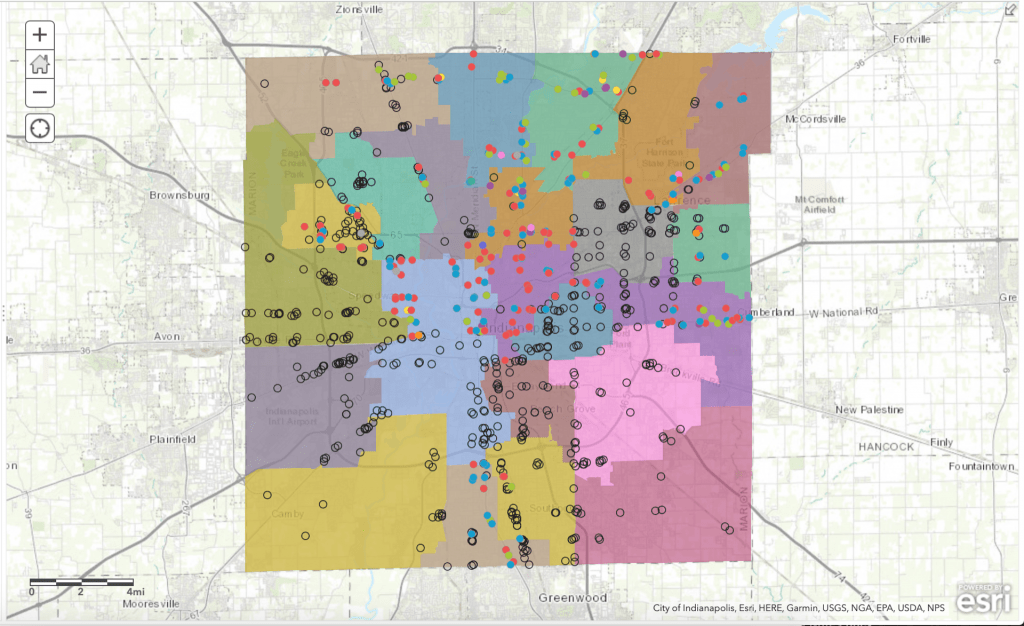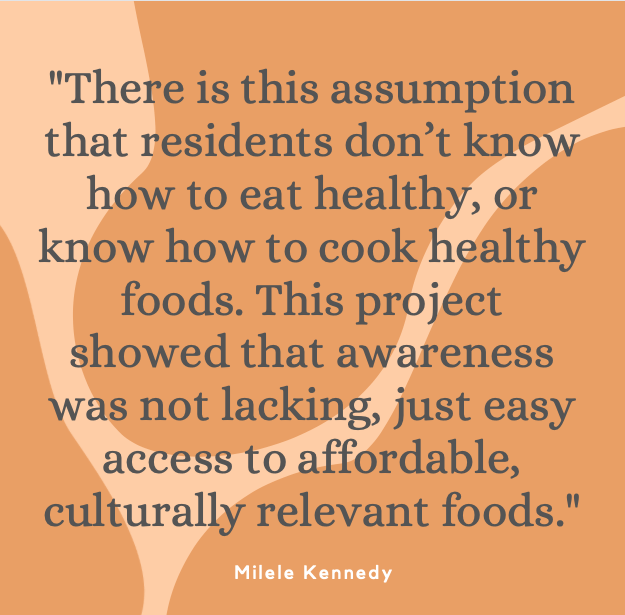Written by project co-lead, Shellye Suttles

How did the Food Comida Rawl 317 (FCR317) project come about?
In Indianapolis Mayor Hogsett’s 2019 State of the City address, he advocated for the creation of a collective vision, mission, and goals for Marion County’s food system to guide residents, community organizations, businesses, and policymakers in efforts to improve long-term food access and food security. For many years, the Mayor’s Office, City-County Council, and diverse food system stakeholders have been trying to tackle these weighty food policy issues, and this renewed charge to work strategically and collectively presented an opportune moment to launch this collaborative partnership.
 Who was on the team?
Who was on the team?
The team was made-up of a robust core organizing committee with representation from the City of Indianapolis, Indiana University, Butler University, and CollaboCreative, and an advisory committee of farmers, food banks, retailers, aggregators, non-profits, and more. This well-rounded make-up helped give the project an insightful and balanced perspective on the local food system. Our diverse professional representation from data experts to community facilitation specialists allowed us to simultaneously analyze data and empirical evidence from previous efforts while also gathering the current needs of community and policymakers to co-create meaningful food policy solutions.
What do “Comida” and “Rawl” mean?
“Comida” means food in Spanish, and “Rawl” means food in Hakha Chin, a Burmese language. Over 10 percent of Indianapolis residents identified as Hispanic or Latino in 2021 (U.S. Census, 2022) and, as of 2020, Indianapolis and Marion County were home to the largest Burmese community in the United States (Indy Star, 2021). We felt it was important to be linguistically inclusive in the research and policy development process, and “Food Comida Rawl” represents the three most prevalent languages of the communities we were working with.
What were the project’s goals and how was it conducted?

Our research effort sought to understand the specific challenges households and food system practitioners face in navigating the Indianapolis and Marion County food systems. We also explored consumer visions and practitioner solutions for improvements to the local food system to achieve greater food security and food access for all residents, at all times.
We used focus groups, surveys, and spatial data visualization and analysis. The first round of data collection involved food system asset mapping, a food store survey, a scan of food policies and programs, a consumer survey, a practitioner survey, and focus groups with food system practitioners. Between March 2020 and December 2021, these elements were analyzed, synthesized, and shared back with local households and food system stakeholders through community focus groups and pop-up events to solicit additional community feedback.
What were some challenges faced over the course of the project?
The project began in March 2020, which was the beginning of the COVID-19 pandemic, so all of our planned in-person events had to be converted to online activities via Zoom, Qualtrics surveys, or the foodcomidarawl317.com website. Project co-lead and Director of Community Nutrition and Food Policy for the City of Indianapolis, Milele Kennedy, shared that “we know that working virtually created barriers for those with a lack of access to electronic devices, older individuals that need assistance with technology and those that need more inclusive supports.” We offered consumer surveys and conducted multi-lingual Zoom meetings in Spanish and Hakha Chin, but still felt that in-person events could have resulted in a broader participant base. “Face-to-face interactions are very valuable,” Kennedy added. ” For FCR317 version 2.0 we would like to begin to offer in person and interactive options for feedback to ensure all residents have equitable access to our program.”
What did the project find?
 Overall, the challenges that residents expressed facing in the local food system were largely cultural and asset-based, with some physical and geographic as well. We found that cultural barriers generally reflected a discrepancy between the healthy diets that households wanted to eat and the culture in which they are trying to eat them. This showed up most prominently when it came to getting groceries, patronizing local restaurants, and trying to eat a healthy diet in all venues.
Overall, the challenges that residents expressed facing in the local food system were largely cultural and asset-based, with some physical and geographic as well. We found that cultural barriers generally reflected a discrepancy between the healthy diets that households wanted to eat and the culture in which they are trying to eat them. This showed up most prominently when it came to getting groceries, patronizing local restaurants, and trying to eat a healthy diet in all venues.
Asset-based challenges in both accessing and preparing food were most commonly regarding the cost of food, time constraints, and limited access to adequate kitchen space and supplies. A majority of households across demographics expressed challenges in preparing food at home and healthy eating and, for low-income households in particular, there was a negative feedback relationship between the lack of time to get groceries and the lack of home resources to prepare food daily.
As one respondent explained, “Time is the big issue. Usually, when I start cooking, everyone is already starving, so I feel pressure to make something fast.” Another respondent shared the challenge of “[having] a limited knowledge of food and what can be done with it.” They also added, “I have two kids under 3 and they are picky.” Ability barriers such as transportation, mobility, and disability, as well as COVID-related difficulties, were other challenge-points found in the study. As one respondent explained, “I live in a food desert. I have to make sure I have all the ingredients at home.” Other respondents indicated that their disabilities inhibit preparing food at home because traveling to the grocery store is challenging or because, as one participant stated, “I get easily fatigued when standing to prepare my meals…I simply do not enjoy anything about cooking.”

According to the food system practitioners in the study, the inequitable landscape of food access in Indianapolis is rooted in poverty and systemic racism, which leads to limited food access and food insecurity. They expressed that community voices and lived experiences are absent from the policy process and that regulations are largely unsupportive of small food retailers and local farmers. Additionally, they expressed that stakeholders often point to organizational and informational silos and the lack of a central communication hub as reasons for a lack of food system information sharing and that, while collaboration is strong around hunger relief due to existing collective impact organizations, it is especially lacking around policy change and systemic root cause work in the broader food system.
What are the next steps in the effort to create a sustainable local food system in Indianapolis?
As a result of our findings from the study, we provided ten policy prototype recommendations that address consumer and practitioner visions for supporting food system equity, diversity, and inclusivity across local food cultures, healthy eating, food access and availability, and incorporation of the community voice, as well as creating asset-based resources for households, effective government programming, and opportunities for food system collaboration and awareness among existing collectives.

We recognize the policy prototype recommendations each have three important components: (1) The City of Indianapolis can design a funding matrix that prioritizes food system improvements as identified by consumers and practitioners; (2) the City of Indianapolis can fund and/or continue to fund existing local programs that meet these priorities and have a record of success; and (3) the City of Indianapolis can experiment with new food system policies and programs, using appropriate evaluation metrics, that may supplement existing policies and programs. To read the full policy prototype recommendations, please check out the full report here.
“This process displayed the value of consistently receiving feedback from residents on the state of food access in Indianapolis.” Kennedy shared. “It is also clear that a more direct approach needs to be developed to ensure minority populations are adequately represented. With this feedback and equitable representation, data can be utilized to ensure equitable food access for all residents.”
What can I do to support the on-going work of FCR317?
If you know of anyone living in Indianapolis and Marion County, Indiana, please let them know to complete the household survey: http://foodcomidarawl317.com/survey/
As with the entire FCR317 website, the household survey is available in English, Spanish, and Hakha Chin.
Leave a Reply